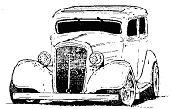 Former custom auto and hot rod creator Bob Metz is shown with his last project, "The Metz," which he built for local attorney Bob Good in 1977. |
Bob Metz
Former Shelbyville auto body shop owner Bob Metz is featured in the current issue of a national hot rod magazine.
Metz, who died in June 1999, designed and created custom cars and hot rods and restored vintage and antique autos from the 1950s through the 1970s. He is the subject of an article written by author Spence Murray called "True Craftsmanship." The story appears in the current summer issue of Rodder's Journal, a coffee table magazine catered to custom auto and hot rod enthusiasts.
"The article about my father is in Rodder's Journal No. 40, the Summer 2008 edition, and is available through the Barnes and Noble bookstore in Indianapolis," said Dennis Metz, son of Bob and Maxine Metz. "The magazine is pretty much the epitome of what's going on in the world of custom cars and hot rodding, drag racing and auto design. About 16 of the magazine pages are devoted to my dad and his cars and features four of the cars he did in the heyday of car design."
According to Metz, his father was an artist who practiced his art in a medium that almost everyone can relate to - the automobile.
"We as Americans have been in love with the automobile since it was invented more than 100 years ago," he said. "You don't have to go to a museum to see the art, because they're right out there for everyone to see. Even to this day, some people can't wait to see what the new cars will look like before they make their first appearance."
According to Metz, his father grew up the ninth of 10 children in a poverty-stricken Lewis Creek home during the Depression 1930s. Although he went no further than the ninth grade, he showed an interest in auto mechanics early when he helped his brother Paul take apart and reassemble their father's Model-T Ford.
"Bob Metz only had abandoned cars as playthings," Murray wrote in his magazine story. "It is likely this rough existence taught him to appreciate auto mechanics and the symmetry and complexity of car design."
Metz said his father was a machinist's mate on a destroyer that sank five German submarines in the Atlantic Ocean. Before being mustered out of the service, he was temporarily sent to New York City and worked on cars belonging to officers stationed in the area.
Without any professional training other than what he learned on his own and in the U.S. Navy, he began his career in mechanic and automobile machine work shortly after returning to Shelbyville after the close of the war. After several years, he was able to concentrate on his passion: auto design and customizing.
In demand
"The 1950s were all about style," Metz said. "Gas and metal were cheap, so it was never about fuel conservation, or even speed."
While most auto body workers used professional metalworking equipment, Metz spent time at junkyards cannibalizing undamaged parts of wrecked vehicles for his labor-intensive, radical custom creations, sometimes cobbling Buick tops to Oldsmobile bodies, together with Chevy grills and Plymouth fenders.
"The cars were so professionally conceived and built, they could easily have been mistaken for Detroit concept cars," Murray wrote.
Metz honed his craft by entering his creations in the annual auto shows in Indianapolis and around the country. In 1954, he won awards for both best custom and best hot rod in the Indianapolis Auto Show at the Indiana State Fairgrounds. As the awards piled up, he began to attract the attention of nationally known car enthusiasts and designers.
"From 1953 to 1957 he had several offers from famous car designer George Barris to go to Detroit and design Buicks, but he always refused," Metz said. "I think growing up poor during the Depression and his experience in World War II made him appreciate home and family. He didn't want to live and work anywhere else and treasured time at home. He wanted to be around his family."
Hollywood calls
Some of Metz's work did make the national spotlight. Seven of his cars were on the cover of Rod and Custom magazine, one of the premier national custom auto journals. One of his creations, the XM105, appeared in the 1950s movie "The Time Machine" and another appeared in the 1950s Jerry Lewis film "Cinderfella." He helped design a car for the 1950s TV series "77 Sunset Strip," as well as a car for the "Batman" TV show and for the TV musical and recording group The Monkees.
For one of his cars, the Golden Sahara, which was done for a Las Vegas auto show, Metz created odd and interesting advanced electronic features, some of which, like remote control car locks and starters, became standard equipment on some later models. He contributed, along with several other famous designers, to the well-known "Dream Truck," and became known in the world of custom cars and hot rods as "The Fin Master" for his sweeping rear and tail assemblies.
When the 1970s brought many changes to the auto design industry, such as the use of less metal and more plastics and fiber glass, higher fuel costs and an accent on cleaner fuels with less fuel emissions, Metz went from customizing cars and hot rods to restoring vintage and antique autos. His last custom creation was "The Metz," which he did for local attorney Bob Good in 1977.
Poor health forced him into retirement in 1992. He is buried alongside his wife, Maxine, at Forest Hill Cemetery.



